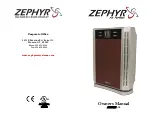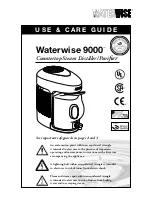
24
LUBRICATION
IMPORTANT: DO NOT
attempt to
lubricate the bearings on the blower
motor or the induced draft blower motor.
Addition of lubricants can reduce the
motor life and void the warranty.
The blower motor and induced draft
blower motor are prelubricated by the
manufacturer and do not require further
attention.
A qualified installer, service agency or
the gas supplier must periodically clean
the motors to prevent the possibility of
overheating due to an accumulation of
dust and dirt on the windings or on the
motor exterior. And, as suggested
elsewhere in these instructions, the air
filters should be kept clean because dirty
filters can restrict air flow and the motor
depends upon sufficient air flowing
across and through it to prevent
overheating.
COOLING SECTION
MAINTENANCE
DISCONNECT MAIN ELECTRICAL
POWER TO THE UNIT BEFORE
ATTEMPTING MAINTENANCE.
FAILURE TO DO SO CAN CAUSE
ELECTRICAL SHOCK RESULTING IN
SEVERE PERSONAL INJURY OR
DEATH.
It is recommended that at the beginning
of each cooling season a qualified
installer or service agency inspect and
clean the cooling section of this unit. The
following areas should be addressed:
evaporator coil. condenser coil,
condenser fan motor and venturi area.
To inspect the evaporator coil:
1. Open the control/filter access panel
and remove filters. Also, remove
blower access panel. In downflow
applications remove the horizontal
return to gain access.
LABEL ALL WIRES PRIOR TO
DISCONNECTION WHEN SERVICING
THE UNIT. WIRING ERRORS CAN
CAUSE IMPROPER AND
DANGEROUS OPERATION
RESULTING IN FIRE, ELECTRICAL
SHOCK, PROPERTY DAMAGE,
SEVERE PERSONAL INJURY OR
DEATH.
2. Shine a flashlight on the evaporator
coil (both sides) and inspect for
accumulation of lint, insulation, etc.
3. If coil requires cleaning, follow the
steps shown below.
Cleaning Evaporator Coil
1. The coil should be cleaned when it is
dry. If the coil is coated with dirt or
lint, vacuum it with a soft brush
attachment. Be careful not to bend
the coil fins.
2. If the coil is coated with oil or grease,
clean it with a mild detergent-and-
water solution. Rinse the coil
thoroughly with water.
IMPORTANT:
Do not
use excessive water
pressure. Excessive water pressure
can bend the fins and tubing of the
coil and lead to inadequate unit
performance. Be careful not to splash
water excessively into unit.
3. Inspect the drain pan and
condensate drain at the same time
the evaporator coil is checked. Clean
the drain pan by flushing with water
and removing any matters of
obstructions which may be present.
4. Go to next section for cleaning the
condenser coil.
Cleaning Condenser Coil, Condenser
Fan, Circulation Air Blower and
Venturi
1. Remove the condenser access end
panel and/or compressor access
louver panel. Disconnect the wires to
the condenser fan motor in the
control box (see wiring diagram).
2. The coil should be cleaned when it is
dry. If the coil is coated with dirt or
lint, vacuum it with a soft brush
attachment. Be careful not to bend
the coil fins.
3. If the coil is coated with oil or grease,
clean it with a mild detergent-and-
water solution. Rinse the coil
thoroughly with water.
IMPORTANT:
Do not
use excessive water
pressure. Excessive water pressure
can bend the fins and tubing of the
coil and lead to inadequate unit
performance. Be careful not to splash
water excessively into unit.
4. The venturi should also be inspected
for items of obstruction such as
collections of grass, dirt or spider
webs. Remove any that are present.
5. Inspect the circulating air blower
wheel and motor for accumulation of
lint, dirt or other obstruction and clean
it necessary. Inspect the blower motor
mounts and the blower housing for
loose mounts or other damage. Repair
or replace if necessary.
Re-assembly
1. Reconnect fan motor wires per the
wiring diagram attached to the back of
the control cover.
2. Replace the control box cover.
3. Close the filter/control access panel
and replace the blower/evaporator coil
access panels.
4. Restore electrical power to the unit
and check for proper operation,
especially the condenser fan motor.
REPLACEMENT PARTS
Contact your local distributor for a
complete parts list.
TROUBLESHOOTING
Refer to Figures 24 and 25 for determining
cause of unit problems.
WIRING DIAGRAMS
Figures 26, 27, 28 and 29 are complete
wiring diagrams for the unit and its power
sources. Also located on back of
compressor access panel.
CHARGING
See Figures 30 and 31 for proper charging
information.
!
WARNING
!
WARNING
Summary of Contents for A180CL25E
Page 30: ...30 FIGURE 26 ...
Page 31: ...31 FIGURE 27 ...
Page 32: ...32 FIGURE 28 ...
Page 33: ...33 FIGURE 29 ...
Page 34: ...34 SYSTEM CHARGE CHARTS FIGURE 30 ...
Page 35: ...35 SYSTEM CHARGE CHARTS FIGURE 31 ...














































